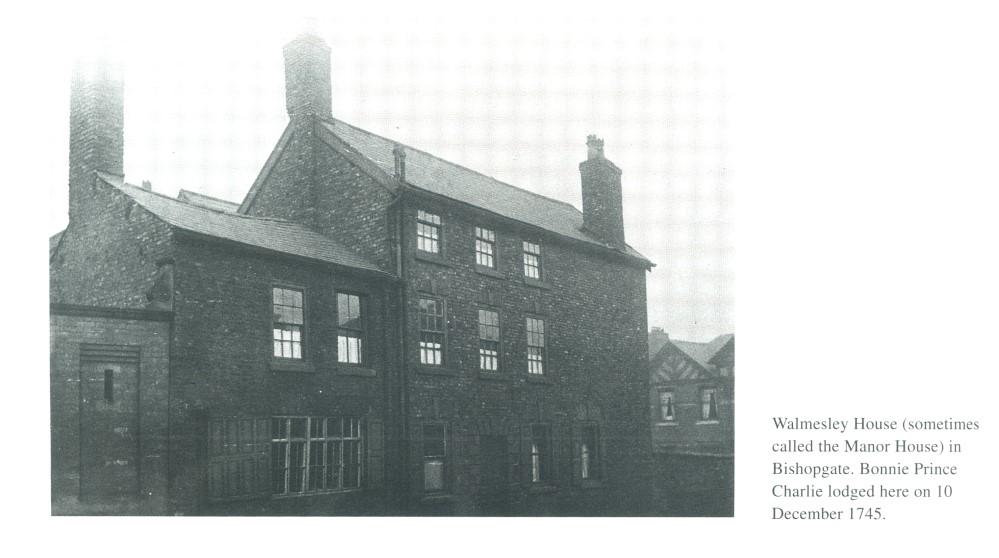Wigan Album
Bishopgate
14 Comments
Photo: RON HUNT
Item #: 30215
With the various named places with the word gate attached, in Wigan. Does anyone know whether, in ancient times, Wigan was a walled town, with gate entrances?.
Albert, part of the Wigan wall is behind the Dog and Partridge near the church entrance.
Thank you Jonno. Possibly quite a few have pondered over this fact. That part of the wall must be several centuries old.
I think it has a date on it Albert, i'll check next time i'm in Wigan.
The wall behind the Dog and Partridge is not a remnant of a town wall. It was built in the 17th century as an ecclesiastical boundary.
It is a popular misconception that Wigan once had a town wall. It never had one.
The term 'gate' affixed to many street names has Norse origins and merely means in this case 'the road to' or 'the way to', as in Standishgate, Millgate, or with Bishopgate, the route the Bishop would approach the church by.
This question has been addressed by many reputable historians and academics, all of whom concur Wigan was never surrounded by a town wall.
Trevor according to Sinclairs History of Wigan It did have walls at one time. As he mentions at night closing the gates to stop attacks from the people of Bolton. I'll see if I can find it in the book, but I'm sure the article is on here?
Ron - Sinclair cannot, in all conscience, be considered a serious historian. He was that popular breed, a Victorian amateur, given to flights of fancy. (I possess both volumes of his history, and can assure you it can only be regarded as an entertainment.)
I was fortunate enough to study at Liverpool under JJ (Joe) Bagley, who many believed to be the 20th century's leading authority on Lancashire history. He stated Wigan was never a walled town, as did his contemporaries.
Trevor is correct.
A lot of Lancashire towns as well as Wigan, like Bolton, Preston and Leigh had streets with gate names, but they never had walls.
They would sometimes have gates on those streets though, but these were only barriers where market tolls could be charged, when carters and cattle drivers were coming into the town, to trade at the market.
Ladies, and gentlemen, this is quite an interesting website.https://lancashirepast.com/2014/07/13/wigans-roman-hypocaust/
I know that the word gate at the end of the name of a street doesn't mean a GATE as such But I suppose we will never know for certain if there was a wall at one time around the town? It appears some Historians say there was and some say they wasn't? I do know that years ago behind the bank at the top of King Street there was supposedly the remains of a Roman Wall. It was in the yard a the back of the bank, backing onto the railway sidings. I've looked since but now its just a modern wall
The wall behind the Dog and Partridge was built in 1683, during the incumbency of Rector John Pearson, to designate the boundary of church property.
Rector Pearson was in the unusual position of being Rector of Wigan and Bishop of Chester, both at the same time.
Wonder what made Joe Bagley so sure. I can't say I've seen any convincing evidence of a stone wall, but both the Rev. Edmund Sibson (writing in 1836) and Rev. A. E. P. Gray, M.A., in a paper in the Wigan Parish Magazine, vol iii.,p. 114 (1879) describe in detail a bank with outer ditch surrounding Wigan (Sibson was convinced it was Roman in origin but, if it did exist, it is likely to be a remnant of the Civil War or maybe Medieval). During the Civil War, after Colonel Assheton had captured the town in 1643, he demolished all out-works and fortification, burnt the new gates and posts and made the townsmen swear not in the future to bear arms against "King and Parliament" (Broxap)
Bill Aldridge - I realise ditch and earthwork type fortifications were erected around the town at different times. These, however, were 'ad hoc' structures.
You say above "I can't say I've seen any convincing evidence of a stone wall". This is also my argument - that Wigan was never a 'walled town' in the manner of Berweick on Tweed, Chester, York, etc.
Hello Everybody There is a little additional 'evidence' to be considered with regard to Wigan's town wall or lack of. King Edward I passed legislation requiring all incorporated royal boroughs, for the protection of the citizens, to be walled. Though I have been unable to trace any confirmation that this was observed by the Lord Rector, mayor & aldermen that does not signify one way or the other. There is though a Roman reference that, given the excellence of their bureaucracy, carries a lot of weight in favour of Wigan having been a walled settlement 1800 years ago. The Itinerarium Antonini Augusti of 213 CE, in effect a road map of the entire empire (originally commissioned by Caligula but left unfinished),listed all towns of any significance. The main criterion for inclusion in this 'atlas' was that all places had to have a town wall. Listed on Itinerary 10 is little old Coccium. That seems a stimulating point from which to start the debate.